As higher education emerges from the depths of the global COVID-19 pandemic, colleges and universities must determine their digital strategy moving forward in this new world.
Most college students now have experience with online learning. The question facing higher ed institutions is how they will invest to support online student retention.
Increase in online learning
Advancement in technology as well as the exposure more students had to online courses is facilitating a significant increase in digital education.
The online student demographic has shifted to include both the prototypical recent high school graduate to adult learners looking to advance their career. While historically the domain of adult learners, younger college students now see the value of taking some or all of their courses online or pursuing things like dual enrollment.
A survey conducted recently by Southern New Hampshire University about reasons for choosing online courses, the most important reasons were based on considerations such as convenience, flexibility, the opportunity to fuse their current lifestyles with their desire to study, availability of programs, and affordability. These drivers were prominent even for younger college students.
According to recent data from the Department of Education’s Integrated Postsecondary Education Data System (IPEDS), 51.8% of students took at least one course online as of the 2019-20 academic year. Most of this data comes from before the pandemic. In addition, the shift to emergency remote learning that took place with the onset of the pandemic in the US in March 2020 has been excluded from these data. This nearly doubles the rate from just a few years ago.
There are also noticeable trends of growth in fully online undergraduate students, even those under the age of 24 years old. Institutions like Southern New Hampshire University and Western Governors witnessed increases of thousands of students in online programs from the past several years. This growth has been accelerated by the pandemic but the trendline started before 2020.
EducationDynamics also noted in their 2022 Online College Students Report, that 87% of surveyed undergraduate and graduate students believed online education was worth the cost. This is a major milestone for the acceptance of online learning.
Drivers of Online Enrollment:
- Rising number of students seeking flexible degrees, often wanting to balance study with part-time or full-time work
- Students enrolled in on-campus programs increasingly choosing hybrid to fully online courses throughout their enrollment
The causes of poor retention
To tackle the problem universities must understand the leading reasons students drop out.
Financial Struggles and Personal Commitments. For adult learners, students who are parents or caregivers as well as students working full-time while they study, there is a delicate life balance that has to be struck for these students to persist.
Relevance and Value. Attracting and retaining students, especially adult learners, also hinges on making a clear and consistent value proposition to them. Enrolling at an institution is a large investment and has a substantial opportunity cost attached to it, so students have to know it is all going to be worth it.
Lack of support. Institutions haven’t always invested fully into serving the needs of online students. It is challenging for staff and faculty not to fall into the trap of online cohorts being ‘out of sight, out of mind.’ Also, institutions haven’t always fully replicated their suite of support resources to be accessible to online students. Investing in digital infrastructure better supports access to resources for all students.
Complex digital ecosystems. Unfortunately, most institutions are stuck using archaic systems, such as their student information system or student portal, which were never developed to cater to online students. They are clunky, difficult to use and fail to create an environment of social engagement.
Lack of community and connection with peers. Particularly in the case of online learners, self-determination theory prescribes the need for a sense of inclusion or affiliation with others (Chen and Jang, 2010). Before online education, many students developed strong relationships with their peers, resulting in a sharing of content, learning and ideas. Without this social connectedness, students are prone to feeling isolated.
The cost of poor retention

Poor retention rates are expensive for students, and institutions.
Obviously, institutions lose out on all of the tuition and fee revenue from students when they stopout. This amount adds up substantially over time and considering the impending enrollment cliff, institutions need to retain as many students as they can given there will be far fewer students to go around.
There are also dramatic impacts for students.The National Student Clearinghouse as recently as July 2020 reported approximately 39 million students in the US with some college credit but no credential. These are students who paid for courses, either from their own pocket or through student loans, and have nothing to show for it in terms of being able to advance their career.
Taking online seriously
Online learning and student retention require an institutional commitment, including innovative approaches to create student community, support and engagement.
There are great tools out there, like Pathify Communities, that create cohesive digital engagement hubs for students to join clubs and communicate with one another.
Given on-campus students also access much of their content online under the blended learning approach, universities should adopt an “online first” attitude to the creation and delivery of student support. That requires ongoing and deliberate consideration of how resources are presented online to be more accessible.
Strategies to increase retention
Create connection and build community
When students feel disconnected and isolated, their chances of success are slim. There are many ways to build community online, including purpose-built technologies. Creating a support network around each student does take effort and persistence, but the potential benefit is immense. Leaders need to take an active approach to building digital community on their campuses.
Communicate personalized information
Personalized communication helps students feel connected to staff and the university. The key is to avoid inundating students with irrelevant information through mass emails. Keep it relevant, frequent and targeted. Otherwise, students will start to ignore the massive amounts of noise around them.
Centralize and prioritize
Universities must approach online learning as a “core business” rather than an aside. They can do this by adopting an institution-wide approach to creating standards, staffing, and resourcing for digital student support resources. The investments made to support online students will also better serve commuter students and adult learners. These students typically have to work while studying so prioritizing putting these resources online will make them more accessible to all students.
Use data effectively
Getting the fundamentals correct first is essential, but once achieved, learning analytics and other techGetting the fundamentals correct first is essential, but once achieved, analytics and other technologies can be used to understand the characteristics and progress of online students better. You can see which students aren’t engaging in clubs or other activities as well as if they are getting behind in their courses.
Create an early intervention strategy
As soon as a student displays any worrisome behaviors, the university should act as swiftly as possible to retain them. This can happen in the form of automatic emails to relevant staff when a student persistently fails to attend class or hand in work, or if they are using keywords in online systems (e.g. “under pressure” or “dropping out”).
Promote support services
Students need to be aware that the university has support services they can access whenever they need them. Support staff should proactively provide information in creative and fun ways, as students are often hesitant to ask for help. This is crucial since simply being reactive isn’t enough. Students have busy lives so they need to be reminded what is available to them to support their success. For example, sending reminders about tutoring throughout the semester and especially around midterms and finals to get students help when they’ll need it most.
Invest in the digital campus
The digital campus is now arguably more important than the physical campus, so a significant investment needs to be made on an ongoing basis. Purchasing the best technologies available in the marketplace is the first step. This is an ongoing process of continuous improvement, however, and it requires leaders to be consistently aware of what else can be done to improve the current needs of their online students.

Published 10/16/18; Updated: 2/24/23
